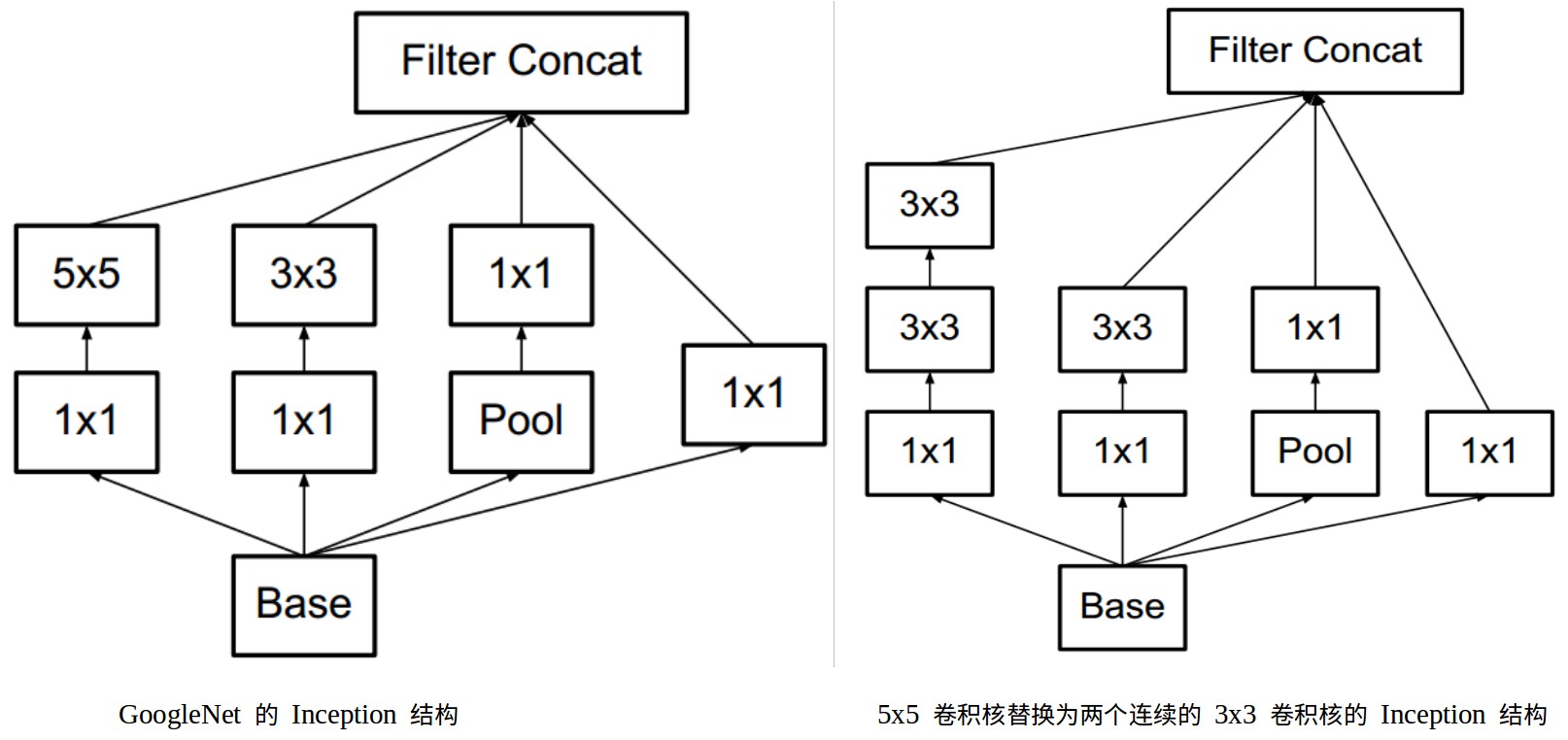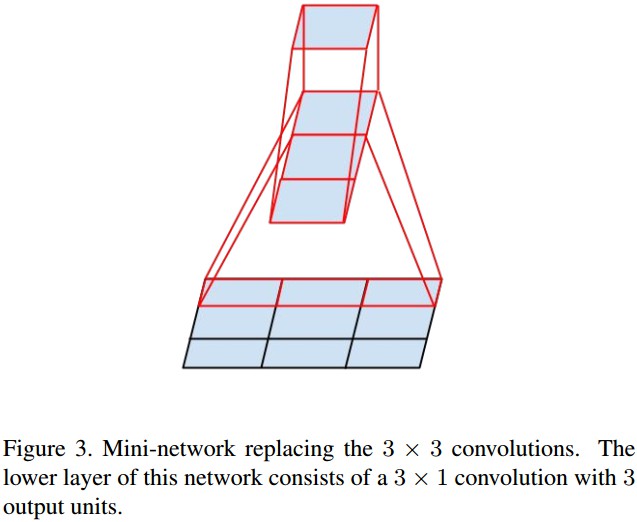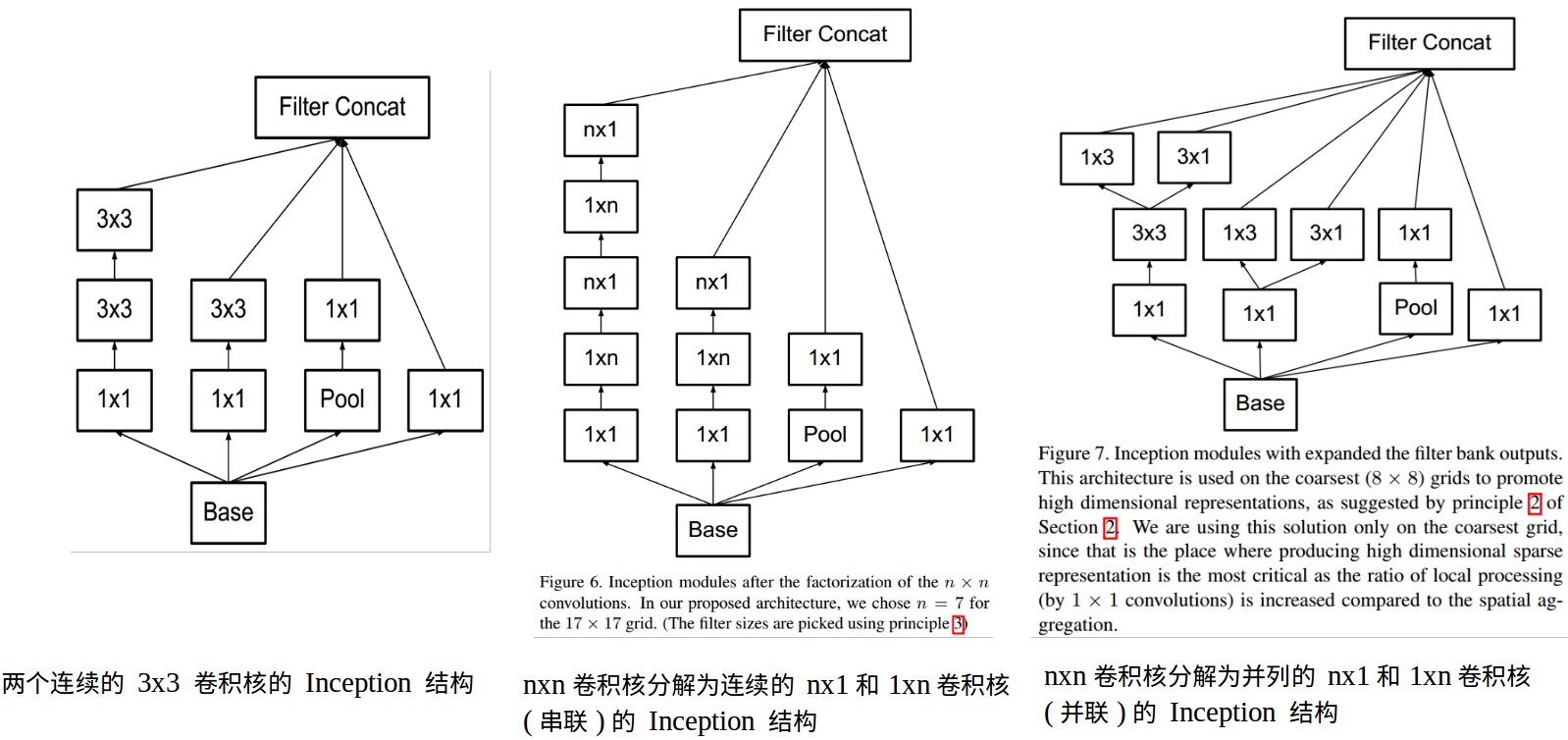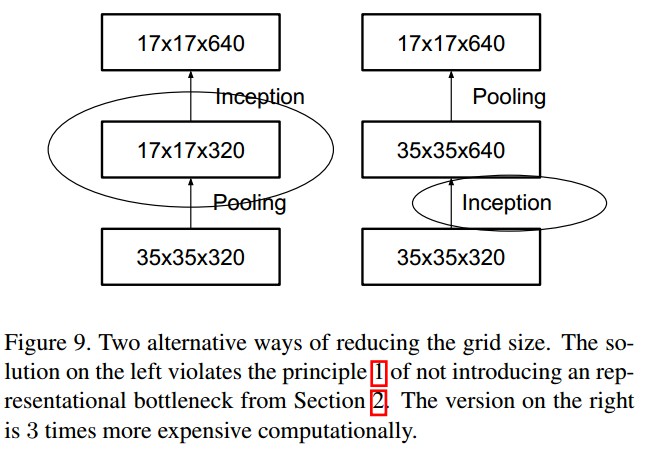Rethinking the Inception Architecture for Computer Vision
1. 卷积网络结构的设计原则(principle)
- [1] - 避免特征表示的瓶颈(representational bottleneck),尤其是网络浅层结构.
前馈网络可以采用由输入层到分类器或回归器的无环图(acyclic graph) 来表示,其定义了信息流的传递方向.
特征表示瓶颈(representational bottleneck) 是指网络中间层会对特征的维度进行较大的压缩(pooling 等操作),从输入到输出特征的尺寸明显减少,出现特征丢失.
理论上,由于特征丢失的问题,比如特征的关联性结构,信息内容不能仅仅由输出的特征表示. 只是提供了粗略的特征估计.
优化网络结构,减少 Pooling 等导致的特征丢失. [2] - 高维的特征表示,易于网络的收敛.
在卷积网络中增加每个区块的激活允许更多解开特征(disentangled features). 网络训练更快.
输入信息被分解,各子特征间的关联性低,子特征内部的相关性强. 这样,将强相关性的特征聚合,更易于网络的收敛.[3] - 低维特征的空间聚合,不会导致特征表示能力的丢失.
例如,在进行更加分散(如,3x3)的卷积前,可以在空间聚合(spatial aggregation)前,可以采用 1x1 卷积核降低输入特征的维度.
其原因,推测为:如果在空间聚合内容中使用输出,临近神经元的强关联性,在降维时不会出现较多的信息损失.[4] - 平衡网络的宽度和深度.
网络宽度和深度的平衡,才能达到最有的网络性能.
2. 分解大尺寸核的卷积
Factorizing Convolutions with Large Filter Size
2.1 大尺寸卷积核分解为小尺寸卷积核
Factorization into smaller convolutions

一个 5x5 卷积核等价于两个连续的 3x3 卷积核.
假设 5x5 和两个连续的 3x3卷积输出的特征数相同,则计算量之比为:5x5/(3x3+3x3)=25/18

2.2 非对称卷积的空间分解
Spatial Factorization into Asymmetric Convolutions

一个 3x3卷积核等价于两个 3x1 卷积核.
将 7x7 卷积核分解成两个卷积核(1x7, 7x1),3x3 卷积核分解为 (1x3, 3x1).
既可以加速计算,又通过将 1 个卷积层分解为 2 个卷积层,加深了网络深度,提高网络的非线性.

3. 有效减少网络尺寸
Efficient Grid Size Reduction
一般情况下,CNN 网络会采用 pooling 操作降低 feature maps 的网格尺寸.
为了避免出现特征表示瓶颈(representational boottleneck)问题,在采用 max 或 ave pooling 操作前,将网络 filters 的激活维度进行扩展(expanded).
例如:对于 k filters 的 dxd 网格,如果要得到 2k filters 的 (d/2)x(d/2) 网格,则,首先需要计算 2k filters 的 stride-1 卷积,然后再进行 pooling 操作. 总的计算量主要是在较大的网格上进行的 2dxdxkxk 次卷积操作.
一种可行的替代方式是,先 pooling 再卷积,则计算量为2(d/2)x(d/2)xkxk,将计算量减少到 1/4. 但,会出现特征表示瓶颈问题,特征表示的维度降低为 (d/2)x(d/2)xk,导致网络表征能力不够好(如图 Figure 9).

这里采用的方式,如 Figure 10,既去除了特征表示瓶颈问题,同时减少了计算量. 采用两个并行的步长 stride-2 操作.

4. Inception V3 网络结构.

采用 Figure 10 中的方法降低不同 Inception 模块间的网格尺寸.
采用 0-padding 的卷积,保持网格尺寸.
在 Inception 模块内部,也会采用 0-padding 的卷积来保持网格尺寸.
5. Tensorflow Slim 的 Inception V3 定义

inception_v3
inception_v3 预训练模型 - inception_v3_2016_08_28.tar.gz
Top-1/78.0
Top-5/93.9
"""
Inception V3 分类网络定义.
"""
from __future__ import absolute_import
from __future__ import division
from __future__ import print_function
import tensorflow as tf
from nets import inception_utils
slim = tf.contrib.slim
trunc_normal = lambda stddev: tf.truncated_normal_initializer(0.0, stddev)
def inception_v3_base(inputs,
final_endpoint='Mixed_7c',
min_depth=16,
depth_multiplier=1.0,
scope=None):
"""
Inception V3 基础网络结构定义.
根据给定的输入和最终网络节点构建 Inception V3 网络.
可以构建表格中从输入到 inception 模块 Mixed_7c 的网络结构.
注:网络层的名字与论文里的不对应,但,构建的网络相同.
old_names 到 new names 的映射:
Old name | New name
=======================================
conv0 | Conv2d_1a_3x3
conv1 | Conv2d_2a_3x3
conv2 | Conv2d_2b_3x3
pool1 | MaxPool_3a_3x3
conv3 | Conv2d_3b_1x1
conv4 | Conv2d_4a_3x3
pool2 | MaxPool_5a_3x3
mixed_35x35x256a | Mixed_5b
mixed_35x35x288a | Mixed_5c
mixed_35x35x288b | Mixed_5d
mixed_17x17x768a | Mixed_6a
mixed_17x17x768b | Mixed_6b
mixed_17x17x768c | Mixed_6c
mixed_17x17x768d | Mixed_6d
mixed_17x17x768e | Mixed_6e
mixed_8x8x1280a | Mixed_7a
mixed_8x8x2048a | Mixed_7b
mixed_8x8x2048b | Mixed_7c
Args:
inputs: Tensor,尺寸为 [batch_size, height, width, channels].
final_endpoint: 指定网络定义结束的节点endpoint,即网络深度.
候选值:['Conv2d_1a_3x3', 'Conv2d_2a_3x3', 'Conv2d_2b_3x3',
'MaxPool_3a_3x3', 'Conv2d_3b_1x1', 'Conv2d_4a_3x3',
'MaxPool_5a_3x3', 'Mixed_5b', 'Mixed_5c', 'Mixed_5d',
'Mixed_6a', 'Mixed_6b', 'Mixed_6c', 'Mixed_6d', 'Mixed_6e',
'Mixed_7a', 'Mixed_7b', 'Mixed_7c'].
min_depth: 所有卷积 ops 的最小深度值(通道数,depth value (number of channels)).
当 depth_multiplier < 1 时,强制执行;
当 depth_multiplier >= 1 时,不是主动约束项.
depth_multiplier: 所有卷积 ops 深度(depth (number of channels))的浮点数乘子.
该值必须大于 0.
一般是将该值设为 (0, 1) 间的浮点数值,以减少参数量或模型的计算量.
scope: 可选变量作用域 variable_scope.
Returns:
tensor_out: 对应到网络最终节点final_endpoint 的输出张量Tensor.
end_points: 外部使用的激活值集合,例如,summaries 和 losses.
Raises:
ValueError: if final_endpoint is not set to one of the predefined values,
or depth_multiplier <= 0
"""
# end_points 保存相关外用的激活值,例如 summaries 或 losses.
end_points = {}
if depth_multiplier <= 0:
raise ValueError('depth_multiplier is not greater than zero.')
depth = lambda d: max(int(d * depth_multiplier), min_depth)
with tf.variable_scope(scope, 'InceptionV3', [inputs]):
with slim.arg_scope([slim.conv2d, slim.max_pool2d, slim.avg_pool2d], stride=1, padding='VALID'):
# 299 x 299 x 3
end_point = 'Conv2d_1a_3x3'
net = slim.conv2d(inputs, depth(32), [3, 3], stride=2, scope=end_point)
end_points[end_point] = net
if end_point == final_endpoint: return net, end_points
# 149 x 149 x 32
end_point = 'Conv2d_2a_3x3'
net = slim.conv2d(net, depth(32), [3, 3], scope=end_point)
end_points[end_point] = net
if end_point == final_endpoint: return net, end_points
# 147 x 147 x 32
end_point = 'Conv2d_2b_3x3'
net = slim.conv2d(net, depth(64), [3, 3], padding='SAME', scope=end_point)
end_points[end_point] = net
if end_point == final_endpoint: return net, end_points
# 147 x 147 x 64
end_point = 'MaxPool_3a_3x3'
net = slim.max_pool2d(net, [3, 3], stride=2, scope=end_point)
end_points[end_point] = net
if end_point == final_endpoint: return net, end_points
# 73 x 73 x 64
end_point = 'Conv2d_3b_1x1'
net = slim.conv2d(net, depth(80), [1, 1], scope=end_point)
end_points[end_point] = net
if end_point == final_endpoint: return net, end_points
# 73 x 73 x 80.
end_point = 'Conv2d_4a_3x3'
net = slim.conv2d(net, depth(192), [3, 3], scope=end_point)
end_points[end_point] = net
if end_point == final_endpoint: return net, end_points
# 71 x 71 x 192.
end_point = 'MaxPool_5a_3x3'
net = slim.max_pool2d(net, [3, 3], stride=2, scope=end_point)
end_points[end_point] = net
if end_point == final_endpoint: return net, end_points
# 35 x 35 x 192.
# Inception blocks
with slim.arg_scope([slim.conv2d, slim.max_pool2d, slim.avg_pool2d], stride=1, padding='SAME'):
# mixed: 35 x 35 x 256.
end_point = 'Mixed_5b'
with tf.variable_scope(end_point):
with tf.variable_scope('Branch_0'):
branch_0 = slim.conv2d(net, depth(64), [1, 1], scope='Conv2d_0a_1x1')
with tf.variable_scope('Branch_1'):
branch_1 = slim.conv2d(net, depth(48), [1, 1], scope='Conv2d_0a_1x1')
branch_1 = slim.conv2d(branch_1, depth(64), [5, 5], scope='Conv2d_0b_5x5')
with tf.variable_scope('Branch_2'):
branch_2 = slim.conv2d(net, depth(64), [1, 1], scope='Conv2d_0a_1x1')
branch_2 = slim.conv2d(branch_2, depth(96), [3, 3], scope='Conv2d_0b_3x3')
branch_2 = slim.conv2d(branch_2, depth(96), [3, 3], scope='Conv2d_0c_3x3')
with tf.variable_scope('Branch_3'):
branch_3 = slim.avg_pool2d(net, [3, 3], scope='AvgPool_0a_3x3')
branch_3 = slim.conv2d(branch_3, depth(32), [1, 1], scope='Conv2d_0b_1x1')
net = tf.concat(axis=3, values=[branch_0, branch_1, branch_2, branch_3])
end_points[end_point] = net
if end_point == final_endpoint: return net, end_points
# mixed_1: 35 x 35 x 288.
end_point = 'Mixed_5c'
with tf.variable_scope(end_point):
with tf.variable_scope('Branch_0'):
branch_0 = slim.conv2d(net, depth(64), [1, 1], scope='Conv2d_0a_1x1')
with tf.variable_scope('Branch_1'):
branch_1 = slim.conv2d(net, depth(48), [1, 1], scope='Conv2d_0b_1x1')
branch_1 = slim.conv2d(branch_1, depth(64), [5, 5], scope='Conv_1_0c_5x5')
with tf.variable_scope('Branch_2'):
branch_2 = slim.conv2d(net, depth(64), [1, 1], scope='Conv2d_0a_1x1')
branch_2 = slim.conv2d(branch_2, depth(96), [3, 3], scope='Conv2d_0b_3x3')
branch_2 = slim.conv2d(branch_2, depth(96), [3, 3], scope='Conv2d_0c_3x3')
with tf.variable_scope('Branch_3'):
branch_3 = slim.avg_pool2d(net, [3, 3], scope='AvgPool_0a_3x3')
branch_3 = slim.conv2d(branch_3, depth(64), [1, 1], scope='Conv2d_0b_1x1')
net = tf.concat(axis=3, values=[branch_0, branch_1, branch_2, branch_3])
end_points[end_point] = net
if end_point == final_endpoint: return net, end_points
# mixed_2: 35 x 35 x 288.
end_point = 'Mixed_5d'
with tf.variable_scope(end_point):
with tf.variable_scope('Branch_0'):
branch_0 = slim.conv2d(net, depth(64), [1, 1], scope='Conv2d_0a_1x1')
with tf.variable_scope('Branch_1'):
branch_1 = slim.conv2d(net, depth(48), [1, 1], scope='Conv2d_0a_1x1')
branch_1 = slim.conv2d(branch_1, depth(64), [5, 5], scope='Conv2d_0b_5x5')
with tf.variable_scope('Branch_2'):
branch_2 = slim.conv2d(net, depth(64), [1, 1], scope='Conv2d_0a_1x1')
branch_2 = slim.conv2d(branch_2, depth(96), [3, 3], scope='Conv2d_0b_3x3')
branch_2 = slim.conv2d(branch_2, depth(96), [3, 3], scope='Conv2d_0c_3x3')
with tf.variable_scope('Branch_3'):
branch_3 = slim.avg_pool2d(net, [3, 3], scope='AvgPool_0a_3x3')
branch_3 = slim.conv2d(branch_3, depth(64), [1, 1], scope='Conv2d_0b_1x1')
net = tf.concat(axis=3, values=[branch_0, branch_1, branch_2, branch_3])
end_points[end_point] = net
if end_point == final_endpoint: return net, end_points
# mixed_3: 17 x 17 x 768.
end_point = 'Mixed_6a'
with tf.variable_scope(end_point):
with tf.variable_scope('Branch_0'):
branch_0 = slim.conv2d(net, depth(384), [3, 3], stride=2,
padding='VALID', scope='Conv2d_1a_1x1')
with tf.variable_scope('Branch_1'):
branch_1 = slim.conv2d(net, depth(64), [1, 1], scope='Conv2d_0a_1x1')
branch_1 = slim.conv2d(branch_1, depth(96), [3, 3], scope='Conv2d_0b_3x3')
branch_1 = slim.conv2d(branch_1, depth(96), [3, 3], stride=2,
padding='VALID', scope='Conv2d_1a_1x1')
with tf.variable_scope('Branch_2'):
branch_2 = slim.max_pool2d(net, [3, 3], stride=2,
padding='VALID', scope='MaxPool_1a_3x3')
net = tf.concat(axis=3, values=[branch_0, branch_1, branch_2])
end_points[end_point] = net
if end_point == final_endpoint: return net, end_points
# mixed4: 17 x 17 x 768.
end_point = 'Mixed_6b'
with tf.variable_scope(end_point):
with tf.variable_scope('Branch_0'):
branch_0 = slim.conv2d(net, depth(192), [1, 1], scope='Conv2d_0a_1x1')
with tf.variable_scope('Branch_1'):
branch_1 = slim.conv2d(net, depth(128), [1, 1], scope='Conv2d_0a_1x1')
branch_1 = slim.conv2d(branch_1, depth(128), [1, 7], scope='Conv2d_0b_1x7')
branch_1 = slim.conv2d(branch_1, depth(192), [7, 1], scope='Conv2d_0c_7x1')
with tf.variable_scope('Branch_2'):
branch_2 = slim.conv2d(net, depth(128), [1, 1], scope='Conv2d_0a_1x1')
branch_2 = slim.conv2d(branch_2, depth(128), [7, 1], scope='Conv2d_0b_7x1')
branch_2 = slim.conv2d(branch_2, depth(128), [1, 7], scope='Conv2d_0c_1x7')
branch_2 = slim.conv2d(branch_2, depth(128), [7, 1], scope='Conv2d_0d_7x1')
branch_2 = slim.conv2d(branch_2, depth(192), [1, 7], scope='Conv2d_0e_1x7')
with tf.variable_scope('Branch_3'):
branch_3 = slim.avg_pool2d(net, [3, 3], scope='AvgPool_0a_3x3')
branch_3 = slim.conv2d(branch_3, depth(192), [1, 1], scope='Conv2d_0b_1x1')
net = tf.concat(axis=3, values=[branch_0, branch_1, branch_2, branch_3])
end_points[end_point] = net
if end_point == final_endpoint: return net, end_points
# mixed_5: 17 x 17 x 768.
end_point = 'Mixed_6c'
with tf.variable_scope(end_point):
with tf.variable_scope('Branch_0'):
branch_0 = slim.conv2d(net, depth(192), [1, 1], scope='Conv2d_0a_1x1')
with tf.variable_scope('Branch_1'):
branch_1 = slim.conv2d(net, depth(160), [1, 1], scope='Conv2d_0a_1x1')
branch_1 = slim.conv2d(branch_1, depth(160), [1, 7], scope='Conv2d_0b_1x7')
branch_1 = slim.conv2d(branch_1, depth(192), [7, 1], scope='Conv2d_0c_7x1')
with tf.variable_scope('Branch_2'):
branch_2 = slim.conv2d(net, depth(160), [1, 1], scope='Conv2d_0a_1x1')
branch_2 = slim.conv2d(branch_2, depth(160), [7, 1], scope='Conv2d_0b_7x1')
branch_2 = slim.conv2d(branch_2, depth(160), [1, 7], scope='Conv2d_0c_1x7')
branch_2 = slim.conv2d(branch_2, depth(160), [7, 1], scope='Conv2d_0d_7x1')
branch_2 = slim.conv2d(branch_2, depth(192), [1, 7], scope='Conv2d_0e_1x7')
with tf.variable_scope('Branch_3'):
branch_3 = slim.avg_pool2d(net, [3, 3], scope='AvgPool_0a_3x3')
branch_3 = slim.conv2d(branch_3, depth(192), [1, 1], scope='Conv2d_0b_1x1')
net = tf.concat(axis=3, values=[branch_0, branch_1, branch_2, branch_3])
end_points[end_point] = net
if end_point == final_endpoint: return net, end_points
# mixed_6: 17 x 17 x 768.
end_point = 'Mixed_6d'
with tf.variable_scope(end_point):
with tf.variable_scope('Branch_0'):
branch_0 = slim.conv2d(net, depth(192), [1, 1], scope='Conv2d_0a_1x1')
with tf.variable_scope('Branch_1'):
branch_1 = slim.conv2d(net, depth(160), [1, 1], scope='Conv2d_0a_1x1')
branch_1 = slim.conv2d(branch_1, depth(160), [1, 7], scope='Conv2d_0b_1x7')
branch_1 = slim.conv2d(branch_1, depth(192), [7, 1], scope='Conv2d_0c_7x1')
with tf.variable_scope('Branch_2'):
branch_2 = slim.conv2d(net, depth(160), [1, 1], scope='Conv2d_0a_1x1')
branch_2 = slim.conv2d(branch_2, depth(160), [7, 1], scope='Conv2d_0b_7x1')
branch_2 = slim.conv2d(branch_2, depth(160), [1, 7], scope='Conv2d_0c_1x7')
branch_2 = slim.conv2d(branch_2, depth(160), [7, 1], scope='Conv2d_0d_7x1')
branch_2 = slim.conv2d(branch_2, depth(192), [1, 7], scope='Conv2d_0e_1x7')
with tf.variable_scope('Branch_3'):
branch_3 = slim.avg_pool2d(net, [3, 3], scope='AvgPool_0a_3x3')
branch_3 = slim.conv2d(branch_3, depth(192), [1, 1], scope='Conv2d_0b_1x1')
net = tf.concat(axis=3, values=[branch_0, branch_1, branch_2, branch_3])
end_points[end_point] = net
if end_point == final_endpoint: return net, end_points
# mixed_7: 17 x 17 x 768.
end_point = 'Mixed_6e'
with tf.variable_scope(end_point):
with tf.variable_scope('Branch_0'):
branch_0 = slim.conv2d(net, depth(192), [1, 1], scope='Conv2d_0a_1x1')
with tf.variable_scope('Branch_1'):
branch_1 = slim.conv2d(net, depth(192), [1, 1], scope='Conv2d_0a_1x1')
branch_1 = slim.conv2d(branch_1, depth(192), [1, 7], scope='Conv2d_0b_1x7')
branch_1 = slim.conv2d(branch_1, depth(192), [7, 1], scope='Conv2d_0c_7x1')
with tf.variable_scope('Branch_2'):
branch_2 = slim.conv2d(net, depth(192), [1, 1], scope='Conv2d_0a_1x1')
branch_2 = slim.conv2d(branch_2, depth(192), [7, 1], scope='Conv2d_0b_7x1')
branch_2 = slim.conv2d(branch_2, depth(192), [1, 7], scope='Conv2d_0c_1x7')
branch_2 = slim.conv2d(branch_2, depth(192), [7, 1], scope='Conv2d_0d_7x1')
branch_2 = slim.conv2d(branch_2, depth(192), [1, 7], scope='Conv2d_0e_1x7')
with tf.variable_scope('Branch_3'):
branch_3 = slim.avg_pool2d(net, [3, 3], scope='AvgPool_0a_3x3')
branch_3 = slim.conv2d(branch_3, depth(192), [1, 1], scope='Conv2d_0b_1x1')
net = tf.concat(axis=3, values=[branch_0, branch_1, branch_2, branch_3])
end_points[end_point] = net
if end_point == final_endpoint: return net, end_points
# mixed_8: 8 x 8 x 1280.
end_point = 'Mixed_7a'
with tf.variable_scope(end_point):
with tf.variable_scope('Branch_0'):
branch_0 = slim.conv2d(net, depth(192), [1, 1], scope='Conv2d_0a_1x1')
branch_0 = slim.conv2d(branch_0, depth(320), [3, 3], stride=2,
padding='VALID', scope='Conv2d_1a_3x3')
with tf.variable_scope('Branch_1'):
branch_1 = slim.conv2d(net, depth(192), [1, 1], scope='Conv2d_0a_1x1')
branch_1 = slim.conv2d(branch_1, depth(192), [1, 7], scope='Conv2d_0b_1x7')
branch_1 = slim.conv2d(branch_1, depth(192), [7, 1], scope='Conv2d_0c_7x1')
branch_1 = slim.conv2d(branch_1, depth(192), [3, 3], stride=2,
padding='VALID', scope='Conv2d_1a_3x3')
with tf.variable_scope('Branch_2'):
branch_2 = slim.max_pool2d(net, [3, 3], stride=2,
padding='VALID', scope='MaxPool_1a_3x3')
net = tf.concat(axis=3, values=[branch_0, branch_1, branch_2])
end_points[end_point] = net
if end_point == final_endpoint: return net, end_points
# mixed_9: 8 x 8 x 2048.
end_point = 'Mixed_7b'
with tf.variable_scope(end_point):
with tf.variable_scope('Branch_0'):
branch_0 = slim.conv2d(net, depth(320), [1, 1], scope='Conv2d_0a_1x1')
with tf.variable_scope('Branch_1'):
branch_1 = slim.conv2d(net, depth(384), [1, 1], scope='Conv2d_0a_1x1')
branch_1 = tf.concat(axis=3, values=[
slim.conv2d(branch_1, depth(384), [1, 3], scope='Conv2d_0b_1x3'),
slim.conv2d(branch_1, depth(384), [3, 1], scope='Conv2d_0b_3x1')])
with tf.variable_scope('Branch_2'):
branch_2 = slim.conv2d(net, depth(448), [1, 1], scope='Conv2d_0a_1x1')
branch_2 = slim.conv2d(
branch_2, depth(384), [3, 3], scope='Conv2d_0b_3x3')
branch_2 = tf.concat(axis=3, values=[
slim.conv2d(branch_2, depth(384), [1, 3], scope='Conv2d_0c_1x3'),
slim.conv2d(branch_2, depth(384), [3, 1], scope='Conv2d_0d_3x1')])
with tf.variable_scope('Branch_3'):
branch_3 = slim.avg_pool2d(net, [3, 3], scope='AvgPool_0a_3x3')
branch_3 = slim.conv2d(
branch_3, depth(192), [1, 1], scope='Conv2d_0b_1x1')
net = tf.concat(axis=3, values=[branch_0, branch_1, branch_2, branch_3])
end_points[end_point] = net
if end_point == final_endpoint: return net, end_points
# mixed_10: 8 x 8 x 2048.
end_point = 'Mixed_7c'
with tf.variable_scope(end_point):
with tf.variable_scope('Branch_0'):
branch_0 = slim.conv2d(net, depth(320), [1, 1], scope='Conv2d_0a_1x1')
with tf.variable_scope('Branch_1'):
branch_1 = slim.conv2d(net, depth(384), [1, 1], scope='Conv2d_0a_1x1')
branch_1 = tf.concat(axis=3, values=[
slim.conv2d(branch_1, depth(384), [1, 3], scope='Conv2d_0b_1x3'),
slim.conv2d(branch_1, depth(384), [3, 1], scope='Conv2d_0c_3x1')])
with tf.variable_scope('Branch_2'):
branch_2 = slim.conv2d(net, depth(448), [1, 1], scope='Conv2d_0a_1x1')
branch_2 = slim.conv2d(
branch_2, depth(384), [3, 3], scope='Conv2d_0b_3x3')
branch_2 = tf.concat(axis=3, values=[
slim.conv2d(branch_2, depth(384), [1, 3], scope='Conv2d_0c_1x3'),
slim.conv2d(branch_2, depth(384), [3, 1], scope='Conv2d_0d_3x1')])
with tf.variable_scope('Branch_3'):
branch_3 = slim.avg_pool2d(net, [3, 3], scope='AvgPool_0a_3x3')
branch_3 = slim.conv2d(
branch_3, depth(192), [1, 1], scope='Conv2d_0b_1x1')
net = tf.concat(axis=3, values=[branch_0, branch_1, branch_2, branch_3])
end_points[end_point] = net
if end_point == final_endpoint: return net, end_points
raise ValueError('Unknown final endpoint %s' % final_endpoint)
def inception_v3(inputs,
num_classes=1000,
is_training=True,
dropout_keep_prob=0.8,
min_depth=16,
depth_multiplier=1.0,
prediction_fn=slim.softmax,
spatial_squeeze=True,
reuse=None,
create_aux_logits=True,
scope='InceptionV3',
global_pool=False):
"""
Inception v3 分类模型.
网络训练的默认图片输入尺寸为 299x299.
默认参数构建的 Inception V3 模型是论文里定义的模型.
也可以通过修改参数 dropout_keep_prob, min_depth 和 depth_multiplier,
定义 Inception V3 的变形.
参数:
inputs: Tensor,尺寸为 [batch_size, height, width, channels].
num_classes: 待预测的类别数.
如果 num_classes=0或None,则忽略 logits 层,
返回 logits 层的输入特征(dropout 层前的网络层).
is_training: 是否是训练阶段.
dropout_keep_prob: 保留的激活值的比例.
min_depth: 所有卷积 ops 的最小深度值(通道数,depth value (number of channels)).
当 depth_multiplier < 1 时,强制执行;
当 depth_multiplier >= 1 时,不是主动约束项.
depth_multiplier: 所有卷积 ops 深度(depth (number of channels))的浮点数乘子.
该值必须大于 0.
一般是将该值设为 (0, 1) 间的浮点数值,以减少参数量或模型的计算量.
prediction_fn: 计算 logits 预测值输出的函数,如softmax.
spatial_squeeze: 如果是 True, logits 的 shape 是 [B, C];
如果是 false,则 logits 的 shape 是 [B, 1, 1, C];
其中,B 是 batch_size,C 是类别数.
reuse: 是否重用网络及网络的变量值.
如果需要重用,则必须给定重用的 'scope'.
create_aux_logits: 是否创建辅助 logits.
scope: 可选变量作用域 variable_scope.
global_pool: 可选 boolean 值,选择是否在 logits 网络层前使用 avgpooling 层.
默认值是 fasle,则采用固定窗口的 pooling 层,将 inputs 降低到 1x1.
inputs 越大,则 outputs 越大.
如果值是 true, 则任何 inputs 尺寸都 pooled 到 1x1.
Returns:
net: Tensor,如果 num_classes 为非零值,则返回 logits(pre-softmax activations).
如果 num_classes 是 0 或 None,则返回 logits 网络层的 non-dropped-out 输入.
end_points: 字典,包含网络各层的激活值.
Raises:
ValueError: if 'depth_multiplier' is less than or equal to zero.
"""
if depth_multiplier <= 0:
raise ValueError('depth_multiplier is not greater than zero.')
depth = lambda d: max(int(d * depth_multiplier), min_depth)
with tf.variable_scope(scope, 'InceptionV3', [inputs], reuse=reuse) as scope:
with slim.arg_scope([slim.batch_norm, slim.dropout], is_training=is_training):
net, end_points = inception_v3_base( inputs, scope=scope, min_depth=min_depth,
depth_multiplier=depth_multiplier)
# Auxiliary Head logits
if create_aux_logits and num_classes:
with slim.arg_scope([slim.conv2d, slim.max_pool2d, slim.avg_pool2d],
stride=1, padding='SAME'):
aux_logits = end_points['Mixed_6e']
with tf.variable_scope('AuxLogits'):
aux_logits = slim.avg_pool2d(aux_logits, [5, 5], stride=3, padding='VALID',
scope='AvgPool_1a_5x5')
aux_logits = slim.conv2d(aux_logits, depth(128), [1, 1], scope='Conv2d_1b_1x1')
# Shape of feature map before the final layer.
kernel_size = _reduced_kernel_size_for_small_input(aux_logits, [5, 5])
aux_logits = slim.conv2d(aux_logits, depth(768), kernel_size,
weights_initializer=trunc_normal(0.01),
padding='VALID', scope='Conv2d_2a_{}x{}'.format(*kernel_size))
aux_logits = slim.conv2d(aux_logits, num_classes, [1, 1], activation_fn=None,
normalizer_fn=None, weights_initializer=trunc_normal(0.001),
scope='Conv2d_2b_1x1')
if spatial_squeeze:
aux_logits = tf.squeeze(aux_logits, [1, 2], name='SpatialSqueeze')
end_points['AuxLogits'] = aux_logits
# Final pooling and prediction
with tf.variable_scope('Logits'):
if global_pool:
# Global average pooling.
net = tf.reduce_mean(net, [1, 2], keep_dims=True, name='GlobalPool')
end_points['global_pool'] = net
else:
# Pooling with a fixed kernel size.
kernel_size = _reduced_kernel_size_for_small_input(net, [8, 8])
net = slim.avg_pool2d(net, kernel_size, padding='VALID',
scope='AvgPool_1a_{}x{}'.format(*kernel_size))
end_points['AvgPool_1a'] = net
if not num_classes:
return net, end_points
# 1 x 1 x 2048
net = slim.dropout(net, keep_prob=dropout_keep_prob, scope='Dropout_1b')
end_points['PreLogits'] = net
# 2048
logits = slim.conv2d(net, num_classes, [1, 1], activation_fn=None,
normalizer_fn=None, scope='Conv2d_1c_1x1')
if spatial_squeeze:
logits = tf.squeeze(logits, [1, 2], name='SpatialSqueeze')
# 1000
end_points['Logits'] = logits
end_points['Predictions'] = prediction_fn(logits, scope='Predictions')
return logits, end_points
inception_v3.default_image_size = 299
def _reduced_kernel_size_for_small_input(input_tensor, kernel_size):
"""
定义核大小,用于对小尺寸的核大小的自动减小.
Define kernel size which is automatically reduced for small input.
创建 graph 时,如果输入图片的尺寸未知,则该函数假设输入图片尺寸足够大.
参数:
input_tensor: 输入 Tensor,尺寸为 [batch_size, height, width, channels].
kernel_size: desired kernel size of length 2: [kernel_height, kernel_width]
Returns:
a tensor with the kernel size.
TODO(jrru): Make this function work with unknown shapes. Theoretically, this
can be done with the code below. Problems are two-fold: (1) If the shape was
known, it will be lost. (2) inception.slim.ops._two_element_tuple cannot
handle tensors that define the kernel size.
shape = tf.shape(input_tensor)
return = tf.stack([tf.minimum(shape[1], kernel_size[0]),
tf.minimum(shape[2], kernel_size[1])])
"""
shape = input_tensor.get_shape().as_list()
if shape[1] is None or shape[2] is None:
kernel_size_out = kernel_size
else:
kernel_size_out = [min(shape[1], kernel_size[0]),
min(shape[2], kernel_size[1])]
return kernel_size_out
inception_v3_arg_scope = inception_utils.inception_arg_scope
PyTorch - InceptionV3
Keras - InceptionV3